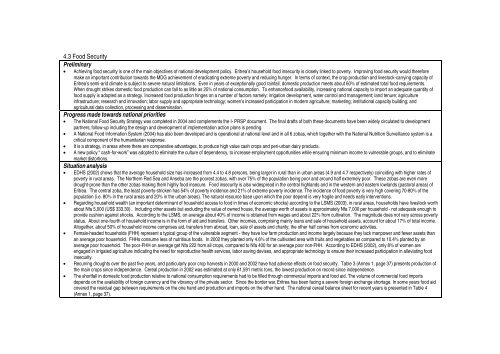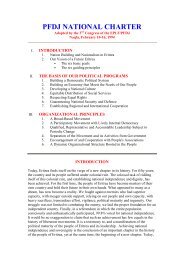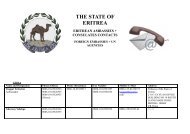Common Country Assessment (CCA) - ECSS | Eritrean Center for ...
Common Country Assessment (CCA) - ECSS | Eritrean Center for ...
Common Country Assessment (CCA) - ECSS | Eritrean Center for ...
Create successful ePaper yourself
Turn your PDF publications into a flip-book with our unique Google optimized e-Paper software.
4.3 Food Security<br />
Preliminary<br />
• Achieving food security is one of the main objectives of national development policy. Eritrea’s household food insecurity is closely linked to poverty. Improving food security would there<strong>for</strong>e<br />
make an important contribution towards the MDG achievement of eradicating extreme poverty and reducing hunger. In terms of context, the crop production and livestock-carrying capacity of<br />
Eritrea’s semi-arid climate is subject to severe natural limitations. Even in years of exceptionally good rainfall, domestic production meets about 60% of estimated total food requirements.<br />
When drought strikes domestic food production can fall to as little as 25% of national consumption. To enhancefood availability, increasing national capacity to import an adequate quantity of<br />
food supply is adopted as a strategy. Increased food production hinges on a number of factors namely: irrigation development, water control and management; land tenure; agriculture<br />
infrastructure; research and innovation; labor supply and appropriate technology; women’s increased participation in modern agriculture; marketing; institutional capacity building; and<br />
agricultural data collection, processing and dissemination.<br />
Progress made towards national priorities<br />
• The National Food Security Strategy was completed in 2004 and complements the I- PRSP document. The final drafts of both these documents have been widely circulated to development<br />
partners; follow-up including the design and development of implementation action plans is pending.<br />
• A National Food In<strong>for</strong>mation System (2004) has also been developed and is operational at national level and in all 6 zobas, which together with the National Nutrition Surveillance system is a<br />
critical component of the humanitarian response.<br />
• It is a strategy, in areas where there are comparative advantages, to produce high value cash crops and peri-urban dairy products.<br />
• A new policy “ cash-<strong>for</strong>-work” was adopted to eliminate the culture of dependency, to increase employment opportunities while ensuring minimum income to vulnerable groups, and to eliminate<br />
market distortions.<br />
Situation analysis<br />
• EDHS (2002) shows that the average household size has increased from 4.4 to 4.8 persons, being larger in rural than in urban areas (4.9 and 4.7 respectively) coinciding with higher rates of<br />
poverty in rural areas. The Northern Red Sea and Anseba are the poorest zobas, with over 75% of the population being poor and around half extremely poor. These zobas are even more<br />
drought-prone than the other zobas making them highly food insecure. Food insecurity is also widespread in the central highlands and in the western and eastern lowlands (pastoral areas) of<br />
Eritrea. The central zoba, the least poverty-stricken has 54% of poverty incidence and 21% of extreme poverty incidence. The incidence of food poverty is very high covering 70-80% of the<br />
population (i.e. 80% in the rural areas and 20% in the urban areas). The natural resource base upon which the poor depend is very fragile and needs early interventions.<br />
• Regarding household wealth (an important determinant of household access to food in times of economic shocks) according to the LSMS (2003), in rural areas, households have livestock worth<br />
about Nfa 5,000 (US$ 333.30) . Including other assets but excluding the value of owned house, the average worth of assets is approximately Nfa 7,000 per household - not adequate enough to<br />
provide cushion against shocks. According to the LSMS, on average about 40% of income is obtained from wages and about 22% from cultivation. The magnitude does not vary across poverty<br />
status. About one-fourth of household income is in the <strong>for</strong>m of aid and transfers. Other incomes, comprising mainly loans and sale of household assets, account <strong>for</strong> about 17% of total income.<br />
Altogether, about 50% of household income comprises aid, transfers from abroad, loan, sale of assets and charity; the other half comes from economic activities.<br />
• Female-headed households (FHH) represent a typical group of the vulnerable segment - they have low farm production and income largely because they lack manpower and fewer assets than<br />
an average poor household. FHHs consume less of nutritious foods. In 2002 they planted only 4.6% of the cultivated area with fruits and vegetables as compared to 10.4% planted by an<br />
average poor household. The poor-FHH on average get Nfa 222 from all crops, compared to Nfa 400 <strong>for</strong> an average poor non-FHH. According to EDHS (2002), only 8% of women are<br />
engaged in irrigated agriculture indicating the need <strong>for</strong> reproductive health services, labor saving devises, and appropriate technology to ensure their increased participation in alleviating food<br />
insecurity.<br />
• Recurring droughts over the past five years, and particularly poor crop harvests in 2000 and 2002 have had adverse effects on food security. Table 3 (Annex 1, page 37) presents production of<br />
the main crops since independence. Cereal production in 2002 was estimated at only 61,591 metric tons, the lowest production on record since independence.<br />
• The shortfall in domestic food production relative to national consumption requirements had to be filled through commercial imports and food aid. The volume of commercial food imports<br />
depends on the availability of <strong>for</strong>eign currency and the vibrancy of the private sector. Since the border war, Eritrea has been facing a severe <strong>for</strong>eign exchange shortage. In some years food aid<br />
covered the residual gap between requirements on the one hand and production and imports on the other hand. The national cereal balance sheet <strong>for</strong> recent years is presented in Table 4<br />
(Annex 1, page 37).





